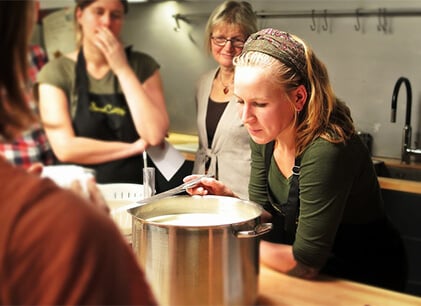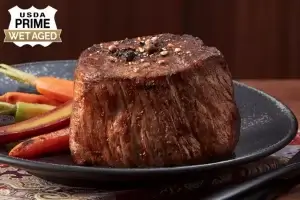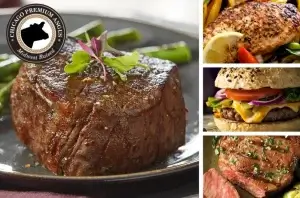
Photo by hfossmark licensed under CC0
If you’re a steak die-hard, it’s pretty much a given that you have a favorite way to cook your steaks. Ask any steak lover and you’ll get a different answer. For some, the smoky flavor that comes with a backyard charcoal grilling is all they dream about. For others, the buttery taste and texture of pan-seared rib-eye is steak-perfection. Meanwhile, for gourmands, the incredibly precise cooking of sous vide means the finest steaks imaginable.
In this article, we take the five most common methods for cooking premium steaks and rank them. We’re talking the methods you use to cook rib-eyes, NY strips, porterhouses, sirloins, and filet mignon.
So which cooking method came out on top?…
Table of Contents
1. Grilling
Pros:
- The best cooking experience
- Pure steak juiciness and texture
- Slightly smoky flavor (when using charcoal)
- Easier to execute than stove/oven methods
Cons:
- Less precise center than sous vide
- Moderate difficulty
The number one spot goes to grilling, the classic method for cooking your steak. While great grilling isn’t quite as precise as sous-vide, it leads to the best, purest-tasting steaks out of non-sous vide methods. This is because grilling uses the steak’s natural fats and juices for flavor.
But grilling doesn’t just lead to a fantastic tasting steak, it’s also just plain enjoyable. Nothing beats a summer evening with a cool drink, tongs, and a roaring charcoal barbecue: there’s a reason the backyard grill is an American staple.
2. Sous Vide
Pros
- The most precisely and evenly cooked centers possible
- The best tasting steaks
- Easy for anyone to use
Cons
- Long cooking times
- Expensive equipment
- Minimal cooking experience
The number two slot goes to sous vide cooking. Sous vide involves vacuum sealing you steak, cooking it for upwards of an hour in temperature controlled water, then finishing it off with a sear. As weird as this method might sound, if you asked a 3-Star Michelin chef, they might think we were crazy for not slotting sous vide at number one. Without a doubt, sous vide leads to the most evenly cooked and best tasting steaks out there.
What really hurts sous vide, though, is the lack of a cooking experience. Outside of the two-minute sear at the end, you don’t get the sensory experience of cooking with sous vide. The smoky, aromatic smell of a strip getting cooked on high heat? The relaxing, mouth-watering time you spend flipping your rib-eye? Neither happen with sous vide cooking. But make no mistake, the end results are exceptional.
3. Sear-Roasting
Pros
- Easiest stovetop/oven method
- Crisp crust produced by pan-searing
Cons
- Less precise centers than grilling or sous vide
- Relies on butter/oil for juiciness and flavor
Coming in at the middle is sear-roasting. Sear-roasting involves pre-heating both your oven and a cast-iron skillet at upwards of 500°F. When both the skillet and oven are piping hot, you put an oiled or buttered steak in the skillet, sear it on both sides, then slip it into the oven to finish cooking.
By searing first, then finishing in the oven, sear-roasting poses less problems than pan-frying and broiling. This method, however, is less accurate than grilling or sous vide, where you can bring a steak more-or-less precisely to temperature, and can lead to over-cooking. It also uses oil/butter for searing, meaning the juiciness of your steak isn’t 100% beef flavor.
4. Pan-Frying
Pros
- Excellent browning and crust
Cons
- Imprecise cooking for center
- Relies on butter/oil for juiciness and flavor
For those who love the taste of butter or vegetable oil, pan-frying steak often produces the best taste. In this case, it’s a matter of personal preference, as a number of steak lovers prefer the juiciness of their steak to come from inside the steak itself.
The biggest problem with pan-frying, however, is that pans retain heat. While it’s easy to transfer a steak from a hotter part of a grill to another, with pan-frying, switching from searing to warming is a less precise process as it takes your pan time to cool down, making it easier to overcook your steak.
5. Broiling
Pros
- Pure steak flavour
Cons
- Very imprecise cooking for center
- Most ovens unable to reach proper temperatures
Coming in last place is broiling. While a favorite method of some steakhouses, broiling – especially at home – can be an unreliable way of cooking your steak. Home ovens are often temperamental when it comes to broiling. They can cook steaks unevenly, or fail to reach high enough temperatures for a properly cooked steak. As a result, you can go through three or four (or potentially more) steaks before you learn how your broiler behaves. Even then, you might find it simply can’t handle the job. Broiling steak also makes it harder to check the temperature, making it easy to under or overcook your steak.
Get Cooking
Learn more about how to grill the perfect steak with Steak University’s own Chef Phillipe and Mark Kranenburg here, or explore some of our side dish recipes to find the perfect pairing for your rib-eye or porterhouse.



